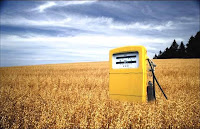 A couple of wheels feel off the biodiesel wagon recently—seems gas and alcohol manufactured from corn, soy and palm may not be the magic bullet we’re desperately seeking.
A couple of wheels feel off the biodiesel wagon recently—seems gas and alcohol manufactured from corn, soy and palm may not be the magic bullet we’re desperately seeking.One study recently—widely reported in places like here—discovered something not very surprising: bulldozing the Amazon rainforest to grow soybeans is not, from a greenhouse gas or biodiversity point of view, ecologically smart.
Seems American farmers once grew corn and soy in rotation, the soybeans enriching soil with nitrogen. But with so much demand on corn for food, corn syrup, and ethanol, farmers have stopped growing soy, and must use more fertilizer to nourish the soil.
And we’ve farmed out soybean production to the Amazon rainforest—which must be clear-cut before being planted. But growing soybeans in the Amazon for soybean biodiesel creates a carbon debt through deforestation that sets us back more than 300 years—it will take us 300 years to earn back the carbon released in deforesting the rainforest.
And using Indonesian peatlands for palm oil plantations is worse, putting so much carbon into the atmosphere it will take us 400 years to repay the debt.
Converting natural habitats into monocultures for alternative fuels is not the direction we should be headed. Rather, we should be using plants like native, wild grasses on degraded agriculture land that can’t be used for anything else.
But, of course, that would be smart, and with energy policy, we’ve always taken the road most traveled—the wrong one. In our headlong rush to break our addiction to Big Oil, burning the Amazon basin to grow biodiesel is a massive mistake.




